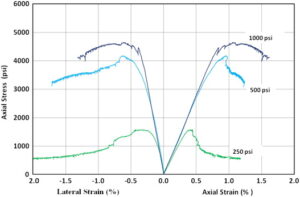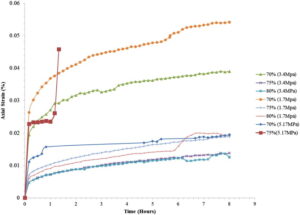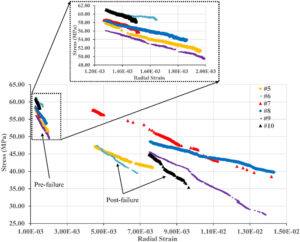My group at University of Utah and West Virginia University has conducted fundamental research on rock behavior. Some of the major topics investigated are as follows
Post Failure behavior coal – We conducted  post-failure tests on rock and coal specimens obtained from various coal mines in West Virginia and Hiawatha. Berea sandstone was used for comparing post-failure behavior of coal measures rock. Two feedback-control modes: axial strain control and lateral strain control modes were used to study the post-failure behaviors of the rock and coal specimens. The results obtained from the experiments show that coal measure rocks show significant change in post-failure behavior when the control modes were changed from axial strain to lateral strain. It was found that when the lateral strain control mode was used, in the post-failure region, coal measures rock exhibited class II behavior. Also coal specimen under lateral strain control showed class II behavior. However, it was observed that when the same coal specimens are tested under confining pressure, the class II behavior is replaced by Class I behavior.
post-failure tests on rock and coal specimens obtained from various coal mines in West Virginia and Hiawatha. Berea sandstone was used for comparing post-failure behavior of coal measures rock. Two feedback-control modes: axial strain control and lateral strain control modes were used to study the post-failure behaviors of the rock and coal specimens. The results obtained from the experiments show that coal measure rocks show significant change in post-failure behavior when the control modes were changed from axial strain to lateral strain. It was found that when the lateral strain control mode was used, in the post-failure region, coal measures rock exhibited class II behavior. Also coal specimen under lateral strain control showed class II behavior. However, it was observed that when the same coal specimens are tested under confining pressure, the class II behavior is replaced by Class I behavior.
Uniaxial and Triaxial Test on coal measures rocks: –
We investigated the time-dependent behavior of laminated shale that is prone to massive roof falls. One particular compressional failure known as “Cutter” roof failure often transforms into massive roof failure within a few days or months. High horizontal stresses also increase the propensity of these failures. In the past few decades, the effects of high horizontal stresses have been studied using numerical models, and these studies have been successful in providing significant insight into their role. H owever, the models did not include any time-dependency analysis of the roof rocks. The main explanation for this has been the absence of data on the time-dependent properties of roof rocks. Therefore, a series of uniaxial and triaxial creep tests were performed on shale specimens to investigate whether roof rock deforms with time and how it fails under complex stress conditions. In uniaxial tests, the load applied to specimens varied from 70 to 85% of their uniaxial compressive strength. When the load was 75 and 85% of the strength, the specimens failed instantaneously. The strain rate changed throughout the test period and did not attain a steady state. Results showed that rocks will deform with time and increasing strain will result in potential failure. In triaxial creep tests, both axial and confining stresses were incremented in stages. Finally, results from these tests showed that the rocks under complex stress conditions will also strain with time and will transform into complete failure of the specimen.
horizontal stresses also increase the propensity of these failures. In the past few decades, the effects of high horizontal stresses have been studied using numerical models, and these studies have been successful in providing significant insight into their role. H owever, the models did not include any time-dependency analysis of the roof rocks. The main explanation for this has been the absence of data on the time-dependent properties of roof rocks. Therefore, a series of uniaxial and triaxial creep tests were performed on shale specimens to investigate whether roof rock deforms with time and how it fails under complex stress conditions. In uniaxial tests, the load applied to specimens varied from 70 to 85% of their uniaxial compressive strength. When the load was 75 and 85% of the strength, the specimens failed instantaneously. The strain rate changed throughout the test period and did not attain a steady state. Results showed that rocks will deform with time and increasing strain will result in potential failure. In triaxial creep tests, both axial and confining stresses were incremented in stages. Finally, results from these tests showed that the rocks under complex stress conditions will also strain with time and will transform into complete failure of the specimen.
Experimental Investigation of Time-Dependent Deformation in Brittle Marcellus Shale
Coal mining activity disturbs the natural equilibrium of in situ stress state such that the induced stresses deform the surrounding rock mass. Although the installation of roof supports typically prevents rock deformation, rock mass failure may still occur in bolted roof. The erratic failure of rock mass after few days to months and years of excavation is the result of time-dependent deformation of roof rock under constant surrounding stresses. In the current research, the triaxial laboratory creep experiments proved that Marcellus shale exhibits time-dependent deformation under constant stress that was smaller than the failure strength. However, unlike conventional experimental results, the time-dependent deformation did not depend on the level of constant stress. The often-neglected initial state of specimens and intrinsic heterogeneity highly influenced the time-dependent failure of Marcellus shale.
https://link.springer.com/article/10.1007/s42461-021-00462-3/figures/11
Laboratory study on the time-dependent behavior of intact and failed sandstone specimens under an unconfined condition with the relaxation test

